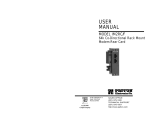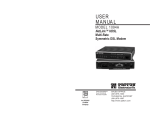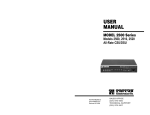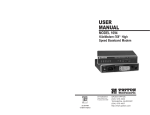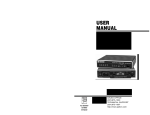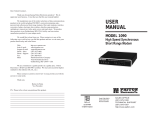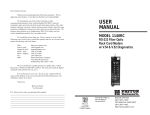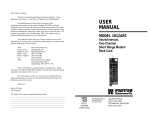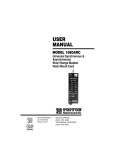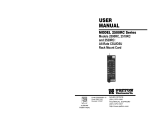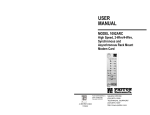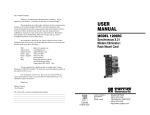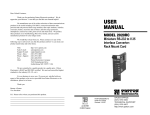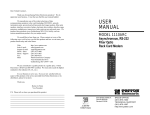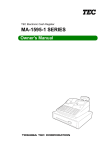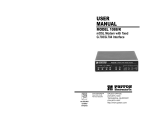Download USER MANUAL MODEL 1092RC High Speed, 2
Transcript
USER MANUAL MODEL 1092RC High Speed, 2-Wire, Synchronous and Asynchronous Rack Mount Modem Card Part# 07M1092RC-E Doc# 033021UE Revised 6/17/98 CERTIFIED An ISO-9001 Certified Company SALES OFFICE (301) 975-1000 TECHNICAL SUPPORT (301) 975-1007 http://www.patton.com TABLE OF CONTENTS Section 1.0 WARRANTY INFORMATION Page 1.0 Warranty Information .............................................................2 1.1 Radio and TV Interference 1.2 CE Notice 1.3 Service Information 2.0 General Information ...............................................................4 2.1 Features 2.2 Description 3.0 Configuration .........................................................................5 3.1 Configuring the Hardware Switches 3.1.1 Reversible Interface Driver Board 3.1.2 Configuration Switch Set “S1” 3.1.3 Configuration Switch Set “S2” 3.2 Configuring the Software Switches 3.2.1 Configuring the Local 1092RC 3.2.2 Configuring the Remote 1092RC 3.3 Configuring the Rear Interface Card 3.3.1 Model 1000RCM12592 Strap Settings 3.3.2 Model 1000RCM13492 Strap Settings 4.0 Installation ...........................................................................24 4.1 The Model 1000R16P Rack Chassis 4.1.1 The Rack Power Supply 4.2 Installing the Model 1092RC Series Into Chassis 4.3.1 Connecting to a “DTE” Device 4.3.2 Connecting to a “DCE” Device 4.3.3 Connecting the Twisted Pair Interface 4.3 Wiring the Model 1092RC Series 5.0 Operation .............................................................................28 5.1 LED Status Indicators 5.2 Test Modes 5.2.1 using Local Line Loopback (LLB) 5.2.2 Using Remote Digital Loopback (RDL) 5.2.3 Using the V.52 (BER Test Pattern Generator Patton Electronics warrants all Model 1092RC components to be free from defects, and will—at our option—repair or replace the product should it fail within one year from the first date of shipment. This warranty is limited to defects in workmanship or materials, and does not cover customer damage, abuse or unauthorized modification. If this product fails or does not perform as warranted, your sole recourse shall be repair or replacement as described above. Under no condition shall Patton Electronics be liable for any damages incurred by the use of this product. These damages include, but are not limited to, the following: lost profits, lost savings and incidental or consequential damages arising from the use of or inability to use this product. Patton Electronics specifically disclaims all other warranties, expressed or implied, and the installation or use of this product shall be deemed an acceptance of these terms by the user. 1.1 RADIO AND TV INTERFERENCE The Model 1092RC generates and uses radio frequency energy, and if not installed and used properly—that is, in strict accordance with the manufacturer's instructions—may cause interference to radio and television reception. The Model 1092RC has been tested and found to comply with the limits for a Class A computing device in accordance with the specifications in Subpart J of Part 15 of FCC rules, which are designed to provide reasonable protection from such interference in a commercial installation. However, there is no guarantee that interference will not occur in a particular installation. If the Model 1092RC does cause interference to radio or television reception, which can be determined by disconnecting the unit, the user is encouraged to try to correct the interference by one or more of the following measures: moving the computing equipment away from the receiver, re-orienting the receiving antenna and/or plugging the receiving equipment into a different AC outlet (such that the computing equipment and receiver are on different branches). In the event the user detects intermittent or continuous product malfunction due to nearby high power transmitting radio frequency equipment, the user is strongly advised to take the following steps: use only data cables with an external outer shield bonded to a metal or metalized connector; and, configure the rear card as shown in section 3.3 of this manual. 1.2 CE NOTICE Appendix A - Specifications ........................................................32 Appendix B - Factory Replacement Parts and Accessories .......33 Appendix C - Terminal Interface Pin Assignments......................34 Appendix D - Control Port Pin Assignments ...............................36 Appendix E - Line Interface Pin Assignments.............................37 1 The CE symbol on your Patton Electronics equipment indicates that it is in compliance with the Electromagnetic Compatibility (EMC) directive and the Low Voltage Directive (LVD) of the European Union. A Certificate of Compliance is available by contacting Technical Support. 2 2.0 GENERAL INFORMATION 1.3 SERVICE All warranty and nonwarranty repairs must be returned freight prepaid and insured to Patton Electronics. All returns must have a Return Materials Authorization number on the outside of the shipping container. This number may be obtained from Patton Electronics Technical Support: tel: (301) 975-1007; email: [email protected]. www: http://www.patton.com. NOTE: Packages received without an RMA number will not be accepted. Thank you for your purchase of this Patton Electronics product. This product has been thoroughly inspected and tested and is warranted for One Year parts and labor. If any questions arise during installation or use of this product, please contact Patton Electronics Technical Support at: (301) 975-1007. 2.1 FEATURES • Synchronous data rates: 9.6, 19.2, 32, 56, 64 and 128 kbps in all clock modes • Asynchronous data rates: 0 - 38.4 kbps • Full duplex operation over a one or two twisted pair (2- or 4-Wires) Patton Electronics' technical staff is also available to answer any questions that might arise concerning the installation or use of your Model 1092RC. Technical Service hours: 8AM to 5PM EST, Monday through Friday. • Point-to-point distances up to 5 miles (8Km) • Remote digital loopback, local line loopback diagnostics • Internal, external or receive recovered clocking options • LED indicators for TD, RD, CTS, CD, DTR, TM, ER and NS • Fits in Patton’s rack chassis and cluster boxes • Made in the U.S.A. 2.2 DESCRIPTION The Patton Model 1092RC KiloModem 2WTM baseband modem allows synchronous or asynchronous data to be transmitted up to 5 miles (8 km) over one or two twisted pair (2 or 4 Wire). Supporting synchronous speeds up to 128 kbps and asynchronous speeds up to 38.4 kbps, the 1092RC is perfect for LAN interconnection or high speed internet links. Supporting 2B1Q encoding, Automatic Equalization and Auto Gain Control, the Model 1092RC compensates for poor line quality. Swappable interface driver boards and interface cards allow the user to easily change applications between RS-232 and V.35. Future driver boards and interface cards will include X.21, G.703, and RS-530. The Model 1092RC also features convenient front panel diagnostic switches and LEDs that allow for easy setup, configuration and testing. The Model 1092RC is designed to fit into Patton’s 2U (3.5”) high rack chassis. This 16-card chassis has a switchable 120/240 VAC power supply (optional 48 VDC) and mounts cards in a mid-plane architecture: The front card can be plugged into different rear cards. 3 4 3.0 CONFIGURATION 3.1.1 Reversible Interface Driver Board This section describes the location and orientation of the Model 1092RC’s configuration switches and jumpers, and provides detailed instructions for all possible settings. 3.1 CONFIGURING THE HARDWARE SWITCHES The Model 1092RC Series features switchable interface driver boards that allow a wide range of DTE interface connections. Each interface driver board incorporates two interfaces -- one on each side of the driver board. Figure 3 shows the Interface Driver Board on the bottom of the 1092RC PC board. ON 1 2 3 4 5 6 7 8 ON 1 2 3 4 5 6 7 8 ON ON 1 2 3 4 5 6 7 8 ON Interface Driver Board 1 2 3 4 5 6 7 8 The Model 1092RC Series front card defaults to the use of hardware switches for configuration. There is an interface driver board strap, and two eight-position DIP switches, on the front card (see Figure 1, below). Interface Driver Board SW1 FRONT THIS SIDE UP FOR V.35 SW2 OFF Figure 3. Closeup of Model 1092RC Interface Driver Board FRONT THIS SIDE UP FOR V.35 Follow the instructions below to select the correct interface for your application: Figure 1. Model 1092RC, showing configuration switches and interface board Figure 2 shows the orientation of the DIP switches with respect to the “ON” and “OFF” positions. 1. With the 1092RC pulled out of the rack or clusterbox chassis, locate the driver board on the top of the 1092RC front card. 2. Lift the interface board gently off of the PC board. 3. Locate the correct interface on the bottom of the driver board. For example, the RS-232/V.35 interface board is marked “THIS SIDE UP FOR RS-232” on one side and “THIS SIDE UP FOR V.35” on the other side . 4. Re-orient the interface board into the socket with the appropriate interface pointed UP and with the arrow pointing toward the front panel of the Model 1092RC PC board. 5. Push the Interface Driver Board gently onto the socket and reinstall into the rack or cluster system. Front Panel ON ON 1 2 3 4 5 6 7 8 OFF Figure 2. Close up of configuration switches (both sets are identical in appearance) NOTE: The ON position is oriented toward the front of the Model 1092RC. 5 6 3.1.2 Configuration DIP Switch Set “S1” Switch S1-3: Data Set Ready During Local Line Loopback Test The configuration switches on S1 allow you to specify the data rate, async/sync data format, transmit clock source and response to RDL request. Default settings of S1 are shown in the table below. Use Switch S1-3 to control the behavior of the DSR signal at the EIA interface during the local line loopback test. Position S1 SUMMARY TABLE Function S1-1 Data Rate On S1-2 Data Rate Off S1-3 DSR during Local Line Loop On S1-4 Async/Sync Data Format Off S1-5 Async/Sync Data Format S1-6 Tx Clock Source S1-7 Tx Clock Source S1-8 Factory Default } Off } On On } Respond to LLB & RDL Request On Sync Data Rate 32 Kbps 56 Kbps 64 Kbps 19.2 or 128 Kbps* Off Disabled Description DSR is on during local line loop (default) DSR is off during local line loop Switches S1-4 and S1-5: Async/Sync Operation DSR Enable Async/Sync Internal Clock Enable Use Switches S1-1and S1-2 to configure the data rate of the Model 1092RC. Each setting represents one synchronous data rate and one asynchronous data rate. S1-2 On On Off Off Setting Enabled 64K Sync Switches S1-1 and S1-2: Data Rate S1-1 On Off On Off S1-3 On Async Data Rate Reserved Reserved Reserved 0 - 38.4 kbps *NOTE: Model 1092RC operates either at a synchronous rate of 19.2 kbps or 128 kbps depending on the orientation of Switch S2. To operate synchronously at 19.2 kbps, set Switch S2-1 ON. To operate at 128 kbps, set Switch S2-1 OFF. See Section 3.1.3 for more information. Use Switches S1-4 and S1-5 to configure the Model 1092 for async/sync operation. Both switches must be set in the “Off” position. There is no other valid setting. S1-4 Off On Off On S1-5 Off Off On On Setting Allows sync/async control Reserved Reserved Reserved Switches S1-6 and S1-7: Transmit Clock Source Use Switches S1-6 and S1-7 to configure the 1092 for internal, external, or receive recover clock mode. S1-6 On S1-7 On Setting Internal Off On External On Off Receive Recover Off Off hardware reset Description Transmit Clock derived internally Transmit Clock derived from the terminal interface Transmit clock derived from the received line signal Important: A pair of Model 1092s communicate synchronously across the twisted pair line connection. Therefore, you must set these switches whether your application is async or sync. For X.21 or Async applications, please configure one Model 1092 for internal clock mode and the other Model 1092 for receive recover clock mode. 7 8 Switch S1-8: Respond to Local and Remote Loop from DTE Switches S2-1, S2-2, S2-3, S2-4: Control Port Address -- LSD Use Switch S1-8 to determine whether the DTE can initiate a local or remote loopback test. When Switch S1-8 is in the On position, the DTE may activate a local or remote loopback test by raising the appropriate interface signal (see Appendix C to determine the local and remote loopback signals). Use Switches S2-1, S2-2, S2-3 and S2-4 to set the least significant digit of the the Model 1092RC control port address. For example, using the table above, if the desired address is “63”, the “3” is the least significant digit in the address, set Switches S2-1, S2-2, S2-3 and S2-4 to OFF OFF ON ON, respectively. Setting Respond to loop request from DTE Interface Do not respond to loop request from DTE Interface S1-8 On Off 3.1.3 DIP Switch Set “S2” - Control Port Address and 19.2 kbps Sync. The Model 1092RC may be configured by a menu-driven software system when used with the Patton Model 1000CC (for ordering information, see Appendix B). In order to configure the Model 1092RC by software commands, you must set its control port address. The control port address is defined by a two digit decimal number. Switches S2-1 through S2-4 define the least significant digit or the “ones” digit, and Switches S2-5 through S2-7 define the “tens” digit. Valid addresses are 0 through 79. Use the table below and the instructions that follow the table to set the the control port to the desired address. *NOTE: You may also use Switch S2-1 to enable 19.2 kbps synchronous operation by setting Switch S2-1 to the ON position. However, when Switch S2-1 is in the ON position, LSD addresses 0, 2, 4, 6, and 8 may not be used for the Control Port Address. Switches S2-5, S2-6, S2-7: Control Port Address -- MSD Use Switches S2-5, 2-6 and S2-7 to set the most significant digit of the Model 1092RC control port address. For example,using the table above, if the desired address is “62”, the “6” is the most significant digit in the address, set Switches S2-5, S2-6, and S2-7 to ON, OFF, OFF, respectively. Switch S2-8: Reserved for Factory Use Switch S2-8 is reserved for factory use and must in the ON position. S2 SUMMARY TABLE Address Digit 0 1 2 3 4 5 6 7 8 Switch S2 Settings 1* 2 3 4 5 6 7 8 ON OFF ON OFF ON OFF ON OFF ON ON ON OFF OFF ON ON OFF OFF ON ON ON ON ON OFF OFF OFF OFF ON ON ON ON ON ON ON ON ON ON ON OFF ON OFF ON OFF ON OFF N/A ON ON OFF OFF ON ON OFF OFF N/A ON ON ON ON OFF OFF OFF OFF N/A ON ON ON ON ON ON ON ON ON NOTE: Default Settings Shown in Bold Italics; Default Address is “10” 9 10 3.2 CONFIGURING THE SOFTWARE SWITCHES 3.2.1 Configuring the Local 1092RC The Model 1092RC features a menu-driven command system that allows you to configure either the local or remote 1092RC. The software control port signals of the 1092RC are carried to each card in the rack along the internal power bus board. Access to all rack card control ports is provided by a single PATTON Model 1000CC Control Card (see Model Model 1000CC User Manual). After setting the control port address (Section 3.1.3), use the following instructions to configure the unit: To configure the local 1092RC, make a selection from the following MAIN MENU. To configure the remote 1092 or 1092RC, type [$] (Shift4) and refer to Section 3.2.2. 1) 2) Connect the serial RS-232 port of a V100 or similar DTE with terminal emulation to the EIA-561 control port on the Model 1000CC control card. To construct an RS-232 to EIA-561 patch cable, refer to the control port pinout diagram in Appendix D. Refer to Appendix C to order a pre-made cable. Power up the terminal and set its RS-232 port as follows: 9600 Baud 8 data bits, i stop bit, no parity Local echo CR-CR/LF on inbound data ANSI, VT-100 emulation 3. Press [CTRL+B] on the terminal followed by the two-digit control port address and press [RETURN]. 4. To make a selection from any menu, enter the option number. To exit any menu without making a selection, press the [ESC] key or the [SPACE] key. 5) After the Model 1092RC is powered on, the control port will send out this message: 2W BBMRC, ver. x.x 6) Press [ESC] on the terminal. 7) The 1092RC will then display the MAIN MENU screen. You may configure the LOCAL Model 1092RC from this screen. To configure the REMOTE Model 1092RC, press ‘$’ (Shift-4 on most keyboards). MAIN MENU Option 1: Display Active Configuration Select Option 1 to display the most recent configuration of the local Model 1092RC (See below). The Model 1092RC uses the active configuration for its operation. If you make changes to the configuration, you must select MAIN MENU Option 8. This will update the unit to the new active configuration. 3.2.2 MAIN MENU Option 2: Display Hardware Configuration Select Option 2 to display the configuration of the hardware DIPswitches. To use the Hardware Configuration for the Active Configuration, select MAIN MENU Option 5. Then select “Use Hardware DIP-Switches”. Finally, select MAIN MENU Option 8 to save. Important!!: To make a selection from any menu, enter the option number. To exit any menu without making a selection, or to return to the previous menu, press the [ESC] key or the [SPACE] key. 11 12 MAIN MENU Option 3: Display Software Configuration b) This menu is displayed when the data format is asynchronous: Select Option 3 to display the configuration of the software switches. To use the software configuration for the Active Configuration, select MAIN MENU, Option 5. Then select “Use Software Switches”. Finally, select MAIN MENU Option 8 to save. 2. Data Format Select Option 2 in the SOFTWARE CONFIGURATION Menu to select the async or sync data format (See below). This option controls whether the unit operates in asynchronous or asynchronous data formats. MAIN MENU Option 4: Setup Software Configuration Select Option 4 toedit the software configuration of the Model 1092RC. To save changes after editing the software configuration, select MAIN MENU Option 5, then select “Use Software Switches” and then select MAIN MENU Option 8. 3. Clock Mode Select Option 3 in the SOFTWARE CONFIGURATION Menu to select the sync clock mode (See below). 1. DTE Rate Select Option 1 in the SOFTWARE CONFIGURATION menu to select the async. or sync. DTE Rate of the Model 1092RC. Different DTE Rate menu screens will display for async. or sync. bit rates. The selections are shown below. a) This menu is displayed when the data format is synchronous: Set this option as follows: Master Clock - Internal: Selection 1 allows the Model 1092RC to generate an internal clock as the timing source. Master Clock - External: Selection 2 allows the Model 1092RC to Derive the system clock from the locally connected DTE. Slaved to Receive Clock: Selection 3 to allows the Model 1092RC to derive the timing source from the incoming data stream from the remote Model 1092RC. 13 14 4. DSR During Local Line Loop 7. DTE Controlled Remote Digital Loop Select Option 4 in the SOFTWARE CONFIGURATION to configure the behavior of the local Data Set Ready (DSR) signal during the Local Line Loop test mode (below). Select Option 7 in the SOFTWARE CONFIGURATION Menu to enable DTE control of the Remote Digital Loop Menu (See below). The Remote Digital Loop on the 1092RC can be controlled from the DTE interface by selecting Enable (Option 1). To instruct the 1092RC to ignore this request from the DTE interface, select Disable (Option 2). 5. Response to Remote Digital Loop 3.2.5 MAIN MENU Option 5: Select Hardware/Software Control Select Option 5 in the SOFTWARE CONFIGURATION Menu to instruct the Model 1092RC to either respond or ignore the Remote Digital Loop request from the remote 1092RC. Select Option 5 from the MAIN MENU selects whether the Model 1092RC will use the hardware switch settings or the software switch settings for its active configuration. If Options 1 or 2 are selected, the 1092RC will use the current hardware or software switch settings as the active configuration. After changing this setting select MAIN MENU Option 8 to implement the changes. 6. DTE Controlled Local Line Loop Select Option 6 in the SOFTWARE CONFIGURATION Menu to instruct the Model 1092RC to either respond or ignore Local Line Loop requests from the DTE. To instruct the Model 1092RC to respond to Local Line Loop requests from the DTE, select Enable (Option 1). To instruct the 1092RC to ignore Local Line Loop requests from the DTE interface, select Disable (Option 2). 15 3.2.6 MAIN MENU Option 6: Display Modem Status Select Option 6 from MAIN MENU to display the Modem Status (below). Press RETURN on the keyboard to update and redisplay the screen. 16 Valid Model 1092RC Handshake status conditions are listed below: 1. 2. Handshaking - This status occurs when the 1092RC is in the process of establishing a link with another 1092RC. Data Mode - This status occurs when the 1092RC successfully establishes a link with another 1092RC allowing the data to flow. Test Mode options 2,3,7,8 and 9 require the 1092RC to be in Data Mode with the remote 1092RC. The Model 1092RC Test Modes are described below: OFF Terminates all tests 511 Initiates the built-in test pattern generator and detector. 511 with Errors Initiates the built-in test pattern generator and detector. The test pattern generator also injects intentional errors approximately once per second. Local Line Loop and 511 Initiates the Local Line Loop test and starts the internal 511 generator and detector. Local Line Loop and 511 w/errors Initiates the Local Line Loop test and starts the internal 511 generator and detector. In this test, the 511 pattern generator injects intentional errors into the data stream. Remote Digital Loop Initiates the Remote Digital Loopback test. Any data sent to the remote 1092RC is returned to the originating device. Remote Digital Loop and 511 Initiates the Remote Digital Loopback test and starts the internal 511 generator and detectors. Remote Digital Loop and 511 with errors Initiates the Remote Digital Loopback test and starts the 511test patterns. In this test the 511 pattern generator will inject initial errors into the data stream. 3.2.7 MAIN MENU Option 7: Test Modes Select Option 7 from the MAIN MENU to select the test mode status of the Model 1092RC. (below). The Model 1092RC Test Mode settings help to verify the integrity of the data link and isolate communication difficulties. NOTE: The 1092RC control port displays an error counter in all test modes except options 4 and 7 listed above. To run or terminate a particular test, key in the option to get to that screen menu. If a particular test cannot be invoked, the unit displays the message: “Attempt unsuccessful!”. 17 The Modem Status Screen is displayed upon initiating a test. A 511 error counter is displayed to indicate errors. Press the ‘C’ key to clear the counter and redisplay the Modem Status Screen. Pressing ‘ESC’ returns you to the Test Mode Menu. 18 3.2.2 Configuring the Remote 1092RC REMOTE MAIN MENU Option 2: Remote Unit Configuration To configure the remote 1092RC, make a selection from the following REMOTE UNIT CONFIGURATION MAIN MENU. To return to the LOCAL 1092RC MAIN MENU screen, press [ESC] and refer to Section 3.2.1. REMOTE MAIN MENU Option 2 allows you to edit the software configuration of the REMOTE Model 1092RC. Please note that after editing the software configuration, you must select REMOTE MAIN MENU Option 4, the select “Use Software Switches” and then select MAIN MENU Option 5 to implement the most recent changes. REMOTE UNIT CONFIGURATION MAIN MENU 1. 2. 3. 4. 5. REMOTE UNIT CONFIGURATION MENU Display Remote Unit Configuration Setup Remote Unit Configuration Display Remote Modem Status Select Hardware /Software Control Restart Remote Unit 1. 2. 3. 4. 5. 6. 7. DTE Rate Clock Mode DSR during Local Line Loop Response Remote Digital Loop DTE Controlled Local Line Loop DTE Controlled Remote Digital Loop 2-Wire/4-Wire Selection (ONLY FOR 1092A) REMOTE MAIN MENU Option 1: Display Remote Unit Configuration Select Option 1 to display the configuration of various parameters in the remote Model 1092RC. REMOTE CONFIGURATION CONFIGURATION DISPLAY MENU 1. Display Configuration of: DSR during Local Line Loop Response to Remote Digital Loop Clock Mode 2. Display Configuration of: Configuration Control DTE Rate 3. Display Configuration of: DTE Controlled Local Line Loop DTE Controlled Remote Digital Loop REMOTE MAIN MENU Option 3: Display Remote Modem Status Select REMOTE MAIN MENU Option 3 to display the status of the REMOTE unit. REMOTE MAIN MENU Option 4: Display Hardware/Software Control Select REMOTE MAIN MENU Option 4 to select whether the remote Model 1092RC will use the hardware switch settings or the software switch settings for its active configuration. REMOTE MAIN MENU Option 5: Restart Remote Unit Select REMOTE MAIN MENU Option 5 to restart the remote unit. NOTE: All REMOTE CONFIGURATION sub-menus are similar to the LOCAL CONFIGURATION sub-menu screens. See Section 3.2.1 for details. 19 20 3.3 CONFIGURING THE REAR INTERFACE CARD 3.3.1 Model 1000RCM12592 Strap Settings The Model 1092RC Series has two interface card options: the Model 1000RCM12592 (DB-25/RJ-45) and the Model 1000RCM13492 (M/34/RJ-45). Each of these options supports one DTE interface connection and one 2-wire line connection. Figure 4 below illustrates the two different interface options for the Model 1092RC Series. Figure 6 shows strap locations for the Model 1000RCM12592 (DB-25/RJ-45S) rear cards. These straps determine various grounding characteristics for the terminal interface and twisted pair lines. JB3 and JB4 are user configurable. JB2 must be set on pegs 1 and 2. Model 1000RCM12592 RJ-45 Model 1000RCM13492 RJ-45 JB2 123 JB3 123 JB4 123 Figure 6. DB-25/RJ-45S strap locations DB-25 F M/34 F Figure 4. Model 1092RC Series interface card options NOTE: The 1092RC Series rear cards are specifically designed to operate with the Model 1092RC function card and must not be swapped with other Patton function cards. Prior to installation, you will need to examine the rear card you have selected and make sure it is properly configured for your application. Each rear card is configured by setting straps located on the PC board. To configure the rear cards, you must set the configuration straps. Figure 5 below shows the orientation of these straps. Each strap can either be on pegs 1 and 2, or on pegs 2 and 3. Sections 3.3.1 and 3.3.2 describe the strap locations and possible settings for each rear card. The table below provides an overview of interface strap functions for the rear interface cards. Following the table overview are detailed descriptions of each strap’s function. INTERFACE CARD STRAP SUMMARY TABLE #1 Strap Function Position 1&2 Position 2&3 JB3 DTE Shield (Pin1) & FRGND Connected Open* JB4 FRGND & SGND Connected Open* * Indicates default setting DTE Shield (DB-25 Pin 1) & FRGND (JB3) In the connected position, this strap links DB-25 pin 1 & frame ground. In the open position, pin 1 is disconnected from frame ground. 1 2 3 1 2 3 connected 1 2 3 open Figure 5. Orientation of Interface Card Straps 21 JB3 Position 1&2 = DTE Shield (Pin 1) and FRGND Connected Position 2&3 = DTE Shield (Pin 1) and FRGND Not Connected 22 4.0 INSTALLATION SGND & FRGND (JB4) In the connected position, this strap links DB-25 pin 7 (Signal Ground) and frame ground. In the open position, pin 1 is disconnected from frame ground. JB4 Position 1&2 = SGND (Pin 7) and FRGND Connected Position 2&3 = SGND (Pin 7) and FRGND Not Connected 3.3.2 Model 1000RCM13492 Strap Settings This section describes the functions of the Model 1000R16 rack chassis, tells how to install front and rear Model 1092RC Series cards into the chassis, and how to connect to the twisted pair interface and the serial interface. 4.1 THE MODEL 1000R16 RACK CHASSIS The Model 1000R16 Rack Chassis (Figure 8, below) has sixteen short range modem card slots, plus its own power supply. Measuring only 3.5” high, the Model 1000R16 is designed to occupy only 2U in a 19” rack. Sturdy front handles allow the Model 1000R16 to be extracted and transported conveniently. Figure 7 shows the strap location for the Model 1000RCM13492 (M/34/RJ-45) rear card. This strap determines whether Signal Ground and Frame Ground will be connected. Figure 8: Model 1000R16 Rack Chassis with power supply 4.1.1 The Rack Power Supply JB4 123 Figure 7. M/34/RJ-45 strap locations SGND & FRGND (JB4) In the connected position, this strap links Signal Ground and frame ground. In the open position, signal ground is disconnected from frame ground. JB4 Position 1&2 = SGND and FRGND Connected Position 2&3 = SGND and FRGND Not Connected 23 The power supply included in the Model 1000R16 rack uses the same mid-plane architecture as the modem cards. The front card of the power supply slides in from the front, and the rear card slides in from the rear. They plug into one another in the middle of the rack. The front card is then secured by thumb screws and the rear card by conventional metal screws. WARNING! There are no user-serviceable parts in the power supply section of the Model 1092RC Series. Voltage setting changes and fuse replacement should only be performed by qualified service personnel. Contact Patton Electronics Technical support at (301)975-1007 for more information. 24 Switching the Power Supply On and Off 4.3.1 Connection to a “DTE” Device The power switch is located on the front panel. When plugged in and switched on, a red front panel LED will glow. Since the Model 1000R16 is a "hot swappable" rack, it is not necessary for any cards to be installed before switching on the power supply. The power supply may be switched off at any time without harming the installed cards. Regardless of the interface module you choose, the Model 1092RC’s serial port is always wired as a DCE. Therefore it “wants” to plug into a DTE such as a terminal, PC or host. When making the connection to your DTE device, use a straight through cable of the shortest possible length that is appropriate to the interface you are using. When purchasing or constructing an interface cable, please refer to the pin diagrams in Appendix C as a guide. NOTE: Please refer to the Model 1000RP Series User Manual AC and DC Rack Mount Power Supplies for fuse and power card replacement information. 4.2 INSTALLING THE MODEL 1092RC SERIES INTO THE CHASSIS The Model 1092RC Series is comprised of a front card and a rear card. The two cards meet inside the rack chassis and plug into each other by way of mating 50 pin card edge connectors. Use the following steps as a guideline for installing each Model 1092RC Series into the rack chassis: 1. Slide the rear card into the back of the chassis along the metal rails provided. 2. Secure the rear card using the metal screws provided. 3. Slide the front card into the front of the chassis. It should meet the rear card when it’s almost all the way into the chassis. 4. Push the front card gently into the card-edge receptacle of the rear card. It should “click” into place. 5. Secure the front card using the thumb screws. 4.3 WIRING THE MODEL 1092RC SERIES Each of the rear interface cards compatible with the Model 1092RC Series has one terminal interface port and one 2-wire (twisted pair) port. For specific interface pin-outs, refer to the diagrams in Appendix C of this manual. . 25 4.3.2 Connection to a “DCE” Device Since the Model 1092RC’s serial port is always wired as a DCE, you must use a null modem cable when connecting to another DCE device such as a CSU/DSU, modem or multiplexer. This cable should be of the shortest possible length that is appropriate to the interface you are using. When purchasing or constructing a null modem interface cable, use the pin diagrams in Appendix C as a guide. Notice! Any terminal cable connected to the Model 1092RC must be shielded cable, and the outer shield must be 360 degree bonded–at both ends–to a metal or metalized backshell. 4.3.3 Connection to the Twisted Pair Interface The Model 1092RC supports communication between two DTE devices at distances to 5 miles (8 km) over 24AWG (.5mm) twisted pair wire. There are two essential requirements for installing the Model 1092RC: 1. These units work in pairs. Therefore, you must have one Model 1092RC (or a compatible model) at each end of a single twisted pair interface. 2. To function properly, the Model 1092RC needs one twisted pair of metallic wire. This twisted pair must be unconditioned, dry, metallic wire, between 19 (.9mm) and 26 AWG (.4mm) (the higher number gauges may limit distance somewhat). Standard dial-up telephone circuits, or leased circuits that run through signal equalization equipment, or standard, flat modular telephone type cable, are not acceptable.. 26 5.0 OPERATION 4.3.4 Two-Wire Cable Connection Via RJ-45 1. The RJ-45 connector on the Model 1092RC’s twisted pair interface is polarity insensitive and is wired for a two-wire interface. The signal/pin relationships are shown in Figure 9 below. 1 (N/C) 2 (GND) 3 (N/C) 4 (Tip) 5 (Ring) 6 (N/C) 7 (GND) 8 (N/C) 1 2 3 4 5 6 7 8 Once the Model 1092RC is properly configured and installed, it should operate transparently. This sections describes functions of the LED status indicators, and the use of the built-in loopback test modes. 5.1 LED STATUS INDICATORS The Model 1092RC features twelve front panel LEDs that monitor power, the DTE signals, network connection and test modes. Figure 10 (below) shows the front panel location of each LED. Following Figure 10 is a description of each LEDs function. Model 1092RC Figure 9. Model 1092RC twisted pair line interface. TD RD CTS 2. Proper wiring of pairs between the two modems is as follows: CD SIGNAL TIP RING PIN# PIN# 4--------------------------------------------- 4 5--------------------------------------------- 5 SIGNAL TIP RING DTR NS TM ER RDL 511 LLB 511ER Notice! Any modular twisted pair cable connected to the Model 1092RC must be shielded cable, and the outer shield must be properly terminated to a shielded modular plug on both ends of the cable. Figure 10. The Model 1092RC Series' front panel LEDs TD & RD glow red to indicate an idle condition of Binary “1” data on the respective terminal interface signals. Green indicates Binary “0” data. CTS consists of 2 LEDs, 1 red, 1 green. CTS glows green to indicate that the Clear to Send signal from the modem is active. Red indicates inactive CTS. CD consists of 2 LEDs, 1 red, 1 green. CD glows red if no carrier signal is being received from the remote modem. Green indicates that the remote modem’s carrier is being received. DTR glows green to indicate that the Data Terminal Ready signal from the terminal is active. 4.3.5 Connection to the Control Port Interface Please refer to the Model 1000CC Control Card user manual for cable requirements of the Control Port Interface. 27 28 ER glows red to indicate the likelihood of a Bit Error in the received signal. During the 511 or 511/E test, ER flashes to indicate that the Test Pattern Detector has detected a bit error. TM glows red to indicate that the Model 1092RC has been placed in Test Mode. The unit can be placed in test mode by the local user or by the remote user. NS (No Signal) glows red to indicate that the local Model 1092RC has not yet connected with the remote Model 1092RC. NOTE: Switch S1-8 must be in the “ON” position). 2. Verify that the data terminal equipment is operating properly and can be used for a test. 3. Perform a V.52 BER (bit error rate) test as described in Section 5.2.3. If the BER test equipment indicates no faults, but the data terminal indicates a fault, follow the manufacturer’s checkout procedures for the data terminal. Also, check the interface cable between the terminal and the Model 1092RC. 5.2.2 Using Remote Digital Loopback (RDL) 5.2 TEST MODES The Model 1092RC offers two proprietary loopback test modes, plus a built-in V.52 BER test pattern generator, to evaluate the condition of the modems and the communication link. These tests can be activated physically from the front panel, or via the interface. 5.2.1 Using Local Line Loopback (LLB) The Remote Digital Loopback (RDL) test checks the performance of both the local and remote Model 1092RCs, and the communication link between them. Any characters sent to the remote Model 1092RC in this test mode will be returned back to the originating device (see Figure 12, below). For example, characters typed on the keyboard of the local terminal will appear on the local terminal screen after having been passed to the remote Model 1092RC and looped back. The Local Line Loopback (LLB) test checks the operation of the local Model 1092RC, and is performed separately on each unit. Any data sent to the local Model 1092RC in this test mode will be echoed (returned) back to the user device (see Figure 11, below). For example, characters typed on the keyboard of a terminal will appear on the terminal screen. Remote 1092RC Local 1092RC Figure 12. Remote Digital Loop 1092RC 1090 To perform an RDL test, follow these steps: 1. Activate RDL. This may be done in two ways: first, by moving the front panel toggle switch to the Left to “Remote”. Second, by raising the RDL signal on the interface (see Appendix C). NOTE: Switch S1-8 must be in the “ON” position. 2. Perform a V.52 BER test as described in Section 5.2.3. If the BER test equipment indicates a fault, and the Local Line Loopback test was successful for both Model 1092RCs, you may have a problem with the twisted pair line between the modems. You should then check the twisted pair line for proper connections and continuity. Figure 11 Local Line Loopback To perform an LLB test, follow these steps: 1. Activate LLB. This may be done in one of two ways: First, by moving the front panel toggle switch to the right to “Local”. Second, by raising the LLB signal on the interface (see Appendix C). Once LLB is activated, the Model 1092RC transmitter output is connected to its own receiver. The “TM” LED should be lit. 29 30 APPENDIX A 5.2.3 Using the V.52 (BER) Test Pattern Generator To use the V.52 BER tests in conjunction with the Remote Digital Loopback tests* (or with Local Line Loopback tests), follow these instructions: 1. Locate the “511/511E” toggle switch on the front panel of the 1092RC and move it to the left. This activates the V.52 BER test mode and transmits a “511” test pattern into the loop. If any errors are present, the local modem’s red “ER” LED will blink sporadically. 2. If the above test indicates no errors are present, move the V.52 toggle switch to the right, activating the “511/E” test with errors present. If the test is working properly, the local modem's red “ER” LED will glow. A successful “511/E” test will confirm that the link is in place, and that the Model 1092RC’s built-in “511” generator and detector are working properly. *NOTE: The above V.52 BER tests can be used independently of the Remote Digital Loopback tests. This requires two operators: one to initiate and monitor the tests at the local Model 1092RC, and one to do the same at the remote Model 1092RC. In this case, the test pattern sent by each Model 1092RC will not be looped back, but will be transmitted down the line to the other Model 1092RC. PATTON MODEL 1092RC SPECIFICATIONS Transmission Format: Transmission Line: Clocking: Distance: Data Rates: Diagnostics: LED Indicators: Connectors: Temperature: Altitude: Humidity: Dimensions: Weight: 31 Synchronous or asynchronous Single unconditioned twisted pair Internal, external or receive recover Up to 10.8 miles (17.3Km), all data rates, 19 AWG (.9mm) Up to 7.2 miles (11.5Km), all data rates, 22 AWG (.6mm) Up to 5 miles (8Km), all data rates, 24AWG (.55mm) Up to 3.41 miles (5.45Km), all data rates, 26 AWG(.4mm) Sync 32, 56, 64 & 128 kbps; Async 0 - 38.4 kbps V.52 compliant bit error rate pattern (511/511E pattern) generator and detector with error injection mode; Local Line Loopback and Remote Digital Loopback, activated by front panel switch or via serial interface TD, RD, CTS, CD, DTR, NS(no signal), ER (error) and TM (test mode) RJ-45 on line side; DB-25 female or M/34 female on serial interface side, depending upon which interface rear card is installed. 32-140°F (0-60°C) 0-15,000 feet (0-4572 meters) 5 to 95% noncondensing Front Card: 4.81” x 3.10” x 0.95” (12.2 x 7.8 x 2.4cm) Rear Card: 3.33” x 2.8” x 0.95” (8.4 x 7.1 x 2.4cm) Front Card: 0.22 lbs (.10Kg) Rear Card (M/34 with V.35 interface): 0.16 lbs (.07Kg) Rear Card (DB-25/RS-232 interface): 0.12 lbs. (.05Kg) 32 APPENDIX B PATTON MODEL 1092RC FACTORY REPLACEMENT PARTS AND ACCESSORIES APPENDIX C MODEL 1092RC TERMINAL INTERFACE PIN ASSIGNMENT M/34F Connector-DCE (V.35 Interface) Description Patton Model # 1000RCM12592.........Rear card w/DB25F & RJ45 (V.24 interface) 1000RCM12492.........Rear card w/ M/34F & RJ45 (V.35 interface) 1000RPEM ................120/240V Rear Power Entry Module 1000RPSM-2 .............120/240V Front Power Supply Module 1000RPEM-DC ..........DC Rear Power Entry Module 1000RPSM-48A.........48V Front Power Supply Module 1000RPEM-V.............120/240V CE Compliant Rear Power Entry Module 1000RPEM-V.............120/240V CE Compliant Rear Power Supply Entry Module 1000CC......................Control Card IM1RC/A ....................Interface daughter card, V24/V.35 0805US......................American Power Cord 0805EUR ...................European Power Cord CEE 7 0805UK......................United Kingdom Power Cord 0805AUS ...................Australia/New Zealand Power Cord 0805DEN ...................Denmark Power Cord 0805FR ......................France/Belgium Power Cord 0805IN .......................India Power Cord 0805IS .......................Israel Power Cord 0805JAP ....................Japan Power Cord 0805SW .....................Switzerland Power Cord 33 Pin # Signal B ...........................SGND (Signal Ground) C ...........................RTS (Request to Send) D ...........................CTS (Clear to Send) E ...........................DSR (Data Set Ready) F............................CD (Carrier Detect) H ...........................DTR (Data Transfer Ready) L ....................................LLB (Local Line Loop) M ...........................TM (Test Mode) N ...........................RDL (Remote Digital Loop) P ...........................TD(Transmit Data) R ...........................RD (Receive Data) S ...........................TD/ (Transmit Data-B) T............................RD/ (Receive Data-B) U ...........................XTC (External Transmit Clock) V ...........................RC(Receive Timing) W ...........................XTC/ (External Transmit Clock) X ...........................RC/ (Receive Timing) Y ...........................TC(Test Control-A) AA ..........................TC/ (Test Control-B) 34 APPENDIX C (Continued) APPENDIX D PATTON MODEL 1092RC TERMINAL INTERFACE PIN ASSIGNMENT PATTON MODEL 1092RC CONTROL PORT PIN ASSIGNMENT DB-25F Connector-DCE (RS-232 Interface) (RJ-45 CONNECTOR ON 1000CC CARD) Pin Function Pin # RJ-45 Pin Number Signal Transmit data (from DTE)................................7 1...........................FG (Frame Ground) 2.......................... TD (Transmit Data) 3...........................RD (Receive Data) 4...........................RTS (Request to Send) 5...........................CTS (Clear to Send) 6...........................DSR (Data Transfer Rate) 7...........................SGND (Signal Ground) 15.........................TC (Test Control-A) 17.........................RC (Receive Timing) 18.........................LLB (Local Line Loop) 20.........................DTR (Data Transfer Rate) 21.........................RDL (Remote Digital Loop) 24.........................XTC (External Transmit Clock 25.........................TM (Test Mode) 35 Receive date (to DTE).....................................6 Ground.............................................................5 36 APPENDIX E Dear Valued Customer, LINE INTERFACE PIN ASSIGNMENT Thank you for purchasing Patton Electronics products! We do appreciate your business. I trust that you find this user manual helpful. (RJ45 Connector) Signal Pin Number 1...................................................N/C (No Connection) 2...................................................N/C (No Connection) 3...................................................N/C (No Connection) 4...................................................Tip 5....................................................Ring 6....................................................N/C (No Connection) 7....................................................N/C (No Connection) 8....................................................N/C (No Connection) We manufacture one of the widest selections of data communications products in the world including CSU/DSU's, network termination units, powered and self-powered short range modems, fiber optic modems, interface converters, baluns, electronic data switches, data-line surge protectors, multiplexers, transceivers, hubs, print servers and much more. We produce these products at our Gaithersburg, MD, USA, facility, and can custom manufacture products for your unique needs. We would like to hear from you. Please contact us in any of the following ways to tell us how you like this product and how we can meet your product needs today and in the future. Web: Sales E-mail: Support E-mail: Phone - Sales Phone - Support Fax: Mail: http://www.patton.com [email protected] [email protected] (301) 975-1000 (301) 975-1007 (301) 869-9293 Patton Electronics Company 7622 Rickenbacker Drive Gaithersburg, MD 20879 USA We are committed to a quality product at a quality price. Patton Electronics is BABT and ISO 9001 certified. We meet and exceed the highest standards in the industry (CE, UL, etc.). It is our business to serve you. If you are not completely satisfied with this product or service provided by Patton Electronics or its distributors, please let us know. Thank you. Burton A.Patton Vice President © Copyright 1997 Patton Electronics Company All Rights Reserved 37 P.S. Please tell us where you purchased this product. _________________________________________________________ _________________________________________________________ _________________________________________________________ _________________________________________________________ _________________________________________________________ _________________________________________________________ _________________________________________________________




















